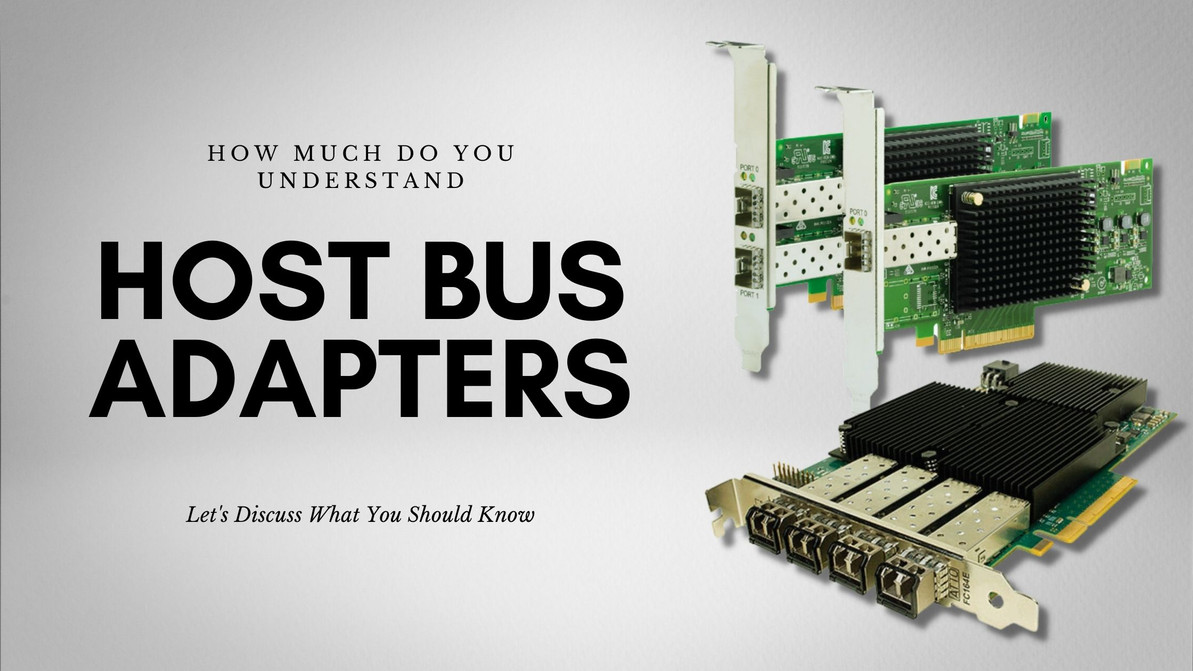How Much Do You Understand HBAs?
Host bus adapters (HBAs) are circuit boards and/or integrated circuits that connect servers to storage devices and perform input/output (I/O) processing. Because HBAs reduce the strain on the host processor while data storage and retrieval activities, server performance may be improved. A disk channel is an HBA and a disk subsystem linked to it
Host bus adapters (HBAs) are devices that connect the host I/O bus to the computer memory system. According to this definition, as video cards are linked to computers and memories, NICs connected to the network bus and memory, SCSI-FC cards linked to the SCSI or FC bus and memory, and they should all be considered HBAs.
FC-HBA adapters and iSCSI HBAs are available for HBA cards, whereas other HBA cards will be made available in the future. Adapter (adapters) and NICs are used in terms of Fibre Channel (FC). Ethernet networks may also be accessed through NICs, but Token Ring networks can only be accessed through adapter (adapters).
Why Are HBAs Important?
Because the server is the SCSI command to the storage device, it can't use the normal LAN network IP protocol, therefore FC transmission was required, so this SAN was dubbed FC-SAN and later came in an IP protocol bundle known as SAN. It may now take ordinary LAN networks; hence they are often referred to as IP-SANs (Internet Storage Connection). The most popular of which is currently ISCSI.
The second way for a remote backup is to use an FTP client program. This method also uses a file transfer protocol (FTP) and must perform a large data packet unpacking operation, so it necessitates using a dedicated network card to limit the strain on the processor.
The HBA card is a NIC that, in addition to the unpacking process, may also provide a fiber interface (if the iSCSI HBA card is configured to provide a common RJ45 interface) to connect it to the associated switch; physically you can insert it into a PCI or PCI slot as a network card, so its usage is quite similar to that of a conventional NIC or a common fiber-optic card. Of course, some iSCSI HBA cards are capable of functioning as regular network cards.
The principle of the HBA
The most frequently used data communication protocol between servers and storage devices is IDE, SCSI, and Fibre Channel. The same data transmission approach must be used on both ends of the communication to ensure successful contact.
On a storage device, the controller is usually accessible, and it supports one or more communication protocols for converting from storage formats such as IDE, SCSI, or Fibre Channel to the physical device's operating protocols.
The server's communication protocol is handled by the expansion card or motherboard, which converts the server bus and IDE and SCSI storage protocols. The IDE protocol features in a PC, for example, while the IDE disk controller resides on the motherboard.
Inside the server host bus adapter card is a little CPU, some memory as a data cache, and fiber channel and bus connection devices are connected. This tiny central processor is responsible for converting PCI and Fiber Channel protocols. It also has other duties such as initialization of the server port linked to the Fiber Channel network, TCP / IP, SCSI, 8B / 10B encoding and decoding support at the higher layer.
Fiber Optic Network Interface Card (NICs) and HBAs
The network card can be split into three categories depending on the transmission mechanism: one is an Ethernet card, the other is a Fiber Channel network card, and the third is an iSCSI network card.
An Ethernet Network Card is a networking device that connects to an Ethernet switch via a fiber optic cable or a twisted pair wire. Optical and electrical interface types are available.
Optical ports are usually transmitted via fiber optic cables, the interface module is generally SFP (transmission rate GB) and GBIC (1GB/s), while the corresponding interface is SC, ST, and LC. RJ45 is currently the most popular interface type; it connects to twisted pair wires as well as coaxial cable, but it is being used less.
nThe nFC Network card - known as a fiber optic network card, scientific name Fibre Channel HBA - is designed to connect to a Fiber Channel switch via a fiber optic cable. The transport protocol is a Fiber Channel protocol, and it usually communicates with a Fiber Channel switch via a fiber optic link. Optical ports and electrical ports are two types of interfaces available.
The physical interface is generally a fiber optic cable for data transmission, with an interface module generally consisting of SFP (transmission rate 2 Gb / s) and GBIC (1Gb / s), and a corresponding electrical connection. The electrical connection's interface type is usually DB9 pin or HSSDC.
The iSCSI Network card – The same as the Ethernet card, the name of the iSCSI HBA, Transport iSCSI protocol, and interface type are all identical.
We use the term "fiber-optic network card" to refer to a FC HBA card, which is plugged into a server and connected via fiber; and “fiber Ethernet card” refers to an external optical Ethernet switch inserted in the server.
Recent Posts
-
Solid Confidence in Every Byte: Powering ProLiant Gen10 and Gen10 Plus Servers with the HPE 960GB LFF Value SAS SSD
HPE 960GB 3.5-inch LFF Digitally Signed Firmware SAS-12Gbps Mixed Use Value SAS Multi Vendor SSD for …Dec 13th 2025 -
Where Reliability Meets Everyday Speed: Empowering ProLiant Gen9 and Gen10 Servers with the HPE 960GB LFF SATA Mixed Use SSD
HPE 960GB 3.5-inch LFF Digitally Signed Firmware SATA-6Gbps Mixed Use SSD for ProLiant Gen9 and Gen1 …Dec 12th 2025 -
The Titanium Heart of Your Datacenter: Unleashing Power with the HPE 960GB LFF Digitally Signed Firmware SAS Enterprise SSD
Powering Enterprise Reliability with the HPE 960GB 3.5-Inch LFF Digitally Signed Firmware TLC SAS-12 …Dec 10th 2025




